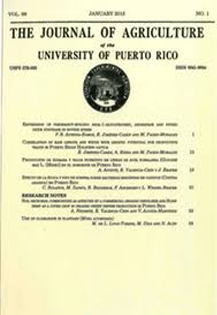Abstract
This study assessed the thermoregulatory capacity of normal-haired Holstein (HLS; n=4), Puerto Rican slick-haired Holstein (HPP; n=4) and Jersey (JRS; n=4) cows in a tropical commercial dairy herd. The vaginal temperature (VT) was monitored using HOBO data loggers for a period of 4.7 consecutive days under regular herd management. In addition, the surface temperature of each animal was determined for two hours under an evaporative cooling system using a thermography camera. The HPP cows had a lower mean VT relative to HLS cows (p<0.05) on each day and hourly during a 24-h diurnal cycle, while JRS cows presented intermediate values relative to HPP and HLS cows. Overall, the 4.7-day study differed among the three groups (p<0.0181), with mean ± standard error values for HPP, JRS and HLS of 38.87±0.02, 39.18±0.03 and 39.35±0.02° C, respectively. When exposed to an evaporative cooling system, the HPP and JRS cows showed lower VT than HLS (p<0.0001); however, no differences were found in surface temperature among racial groups. The results indicate that HPP cows have a greater thermoregulatory capacity relative to HLS and JRS under local management conditions, while HLS cows have the poorest. Additional studies are needed to determine the effect of the superior thermoregulatory capacity observed in HPP cows on feed efficiency, productive and reproductive performance to justify the use of HLS in tropical dairy production systems.Downloads
Download data is not yet available.

